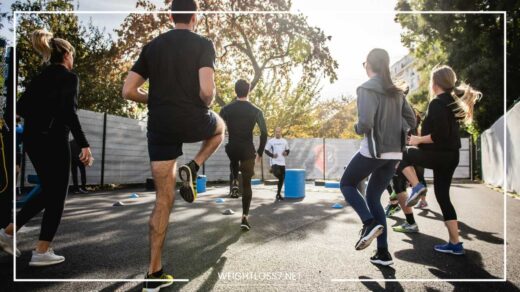Weight Training for Weight Loss

Weight Training
Weight Training for Weight Loss: A Comprehensive Guide
Weight training, or resistance training, is often associated with building muscle mass and strength. However, it’s an incredibly effective and valuable tool for weight loss as well.
While cardio exercises like running, cycling, or swimming are typically viewed as essential for burning fat, weight training has unique advantages that can significantly accelerate and complement fat loss efforts.
Not only does it help you burn calories, but it can also enhance your metabolic rate, improve body composition, and boost overall health.
In this comprehensive guide, we will explore how weight training aids in weight loss, how to effectively incorporate it into your fitness routine, common mistakes to avoid, and essential tips for optimizing your weight loss journey.
How Does Weight Training Aid in Weight Loss?
Understanding the science behind weight training and how it supports weight loss is the key to maximizing its benefits. Here’s how weight training helps with fat loss:
1. Increased Muscle Mass and Resting Metabolism
- Muscle Tissue Burns More Calories at Rest: Muscle is metabolically active tissue, meaning it burns more calories even when you’re not exercising. While fat stores energy and doesn’t require much energy to sustain, muscle requires calories to maintain itself. As you increase your muscle mass through resistance training, your resting metabolic rate (RMR) increases. This means that your body will naturally burn more calories throughout the day, even while at rest.
- Body Composition Over Scale Weight: Weight training can change your body composition even if the number on the scale doesn’t shift much. You might gain lean muscle while simultaneously losing fat, which results in a leaner and more toned physique. This is why people who lift weights often experience a transformation in how they look and feel, even without dramatic weight loss.
2. Caloric Expenditure During and After Exercise (EPOC)
- Calories Burned During the Workout: Just like cardio, weight training itself burns calories. The intensity of the exercise, the muscle groups involved, and the duration of the session all influence how many calories you burn. Lifting heavy weights or performing high-intensity training (such as supersets or circuit training) can burn a significant amount of calories in a relatively short period.
- Afterburn Effect (EPOC): Weight training has a unique benefit known as Excess Post-Exercise Oxygen Consumption (EPOC), or the afterburn effect. After a weight training session, your body continues to burn calories at an elevated rate for hours, even up to 24–48 hours after the workout. This is because your muscles require energy to repair themselves and rebuild stronger. The more intense your workout, the longer and more significant this effect will be.
3. Appetite Regulation and Hormonal Balance
- Leptin and Ghrelin: Resistance training can influence hunger-regulating hormones, such as leptin and ghrelin. Leptin helps signal fullness to your brain, while ghrelin stimulates hunger. Weight training can improve the sensitivity of these hormones, helping to regulate appetite. Studies suggest that weight training may reduce feelings of hunger and cravings, making it easier to maintain a calorie deficit.
- Insulin Sensitivity: Resistance training improves insulin sensitivity, which is crucial for controlling blood sugar levels. The better your body handles insulin, the less likely it is to store excess calories as fat. Enhanced insulin sensitivity also makes it easier for your body to use carbohydrates as fuel during exercise rather than storing them as fat.
4. Fat Reduction and Increased Lean Muscle Mass
- Fat Burning Efficiency: While you cannot spot-reduce fat from specific areas, weight training helps reduce overall body fat. When combined with a balanced diet, weight training promotes fat loss by increasing muscle mass and elevating your metabolism. Over time, this leads to a reduction in body fat percentage, even if your weight doesn’t drop drastically.
- Body Shaping and Tone: Weight training helps define and sculpt your body. As muscle mass increases, it fills out your frame and creates a more toned and sculpted appearance. This is why many people look leaner and more defined after a consistent resistance training program, even without a significant reduction in total weight.
Getting Started with Weight Training for Weight Loss
Now that we’ve explored the science behind weight training and its benefits for fat loss, let’s discuss how to incorporate weight training into your routine effectively.
1. Consult a Professional
- Personalized Plan: It’s always beneficial to consult a certified personal trainer, especially if you are new to weight training or have specific goals in mind. A professional can design a personalized workout plan based on your fitness level, goals, and any medical conditions or limitations. This ensures that you are training safely and effectively.
- Form and Technique: Proper form is essential to prevent injury and maximize the benefits of each exercise. A personal trainer can teach you the correct techniques and help you perform exercises correctly, especially when lifting heavy weights. Bad form can lead to strains, sprains, or even long-term joint damage.
2. Basic Workout Structure for Weight Loss
- Frequency: Aim to incorporate weight training 2–3 times per week. This allows you to target different muscle groups while giving them adequate time to recover. If you’re new to weight training, start with two sessions per week and gradually increase the frequency as your strength improves.
- Exercise Selection: A balanced workout routine should include both compound exercises and isolation exercises:
- Compound Exercises: These exercises target multiple muscle groups at once and burn more calories. Examples include squats, deadlifts, lunges, bench presses, and rows. These exercises engage your body’s largest muscles and are essential for fat loss.
- Isolation Exercises: These exercises focus on a single muscle group, helping to target specific areas for improvement. Examples include bicep curls, tricep extensions, and leg extensions. While isolation exercises are important for muscle shaping, they should be combined with compound exercises for maximum fat-burning results.
- Progressive Overload: As you get stronger, you need to progressively increase the resistance you’re using to continue making progress. This could mean adding more weight, increasing the number of sets or repetitions, or performing more challenging variations of exercises. Progressive overload is a key principle for muscle growth and fat loss.
3. Key Weight Training Exercises
Here are some of the best exercises to include in your routine:
- Squats: A fundamental lower-body exercise that targets the quadriceps, hamstrings, glutes, and core. Variations include bodyweight squats, goblet squats, and barbell squats.
- Deadlifts: Engage the back, hamstrings, glutes, and core. Deadlifts are excellent for overall strength and conditioning, making them a cornerstone of any fat-loss training plan.
- Lunges: Target the legs and glutes. Lunges can be done with body weight or with dumbbells or a barbell for added resistance.
- Bench Press: A classic upper-body exercise that targets the chest, shoulders, and triceps. Variations include flat, incline, and decline bench presses.
- Rows: Focus on the back, biceps, and forearms. Barbell or dumbbell rows are great for improving posture and building upper body strength.
- Pull-Ups: A challenging bodyweight exercise that targets the back and biceps. If you’re not yet able to perform a pull-up, assisted variations or lat pulldowns are excellent alternatives.
- Overhead Press: Targets the shoulders and triceps, helping to build upper body strength and stability.
4. Nutrition and Hydration
- Caloric Deficit: To lose weight, you need to be in a caloric deficit, meaning you must consume fewer calories than your body burns. However, avoid drastic calorie cuts, as this can lead to muscle loss. A moderate deficit of 250–500 calories per day is usually sustainable for long-term fat loss.
- Protein: Protein is essential for muscle repair and growth, especially when combined with weight training. Aim for 1.2 to 2.0 grams of protein per kilogram of body weight to support muscle recovery and fat loss.
- Carbohydrates and Fats: Don’t fear carbs or fats. Both macronutrients play important roles in providing energy for workouts and supporting overall health. Focus on complex carbs (such as whole grains, fruits, and vegetables) and healthy fats (like avocado, nuts, seeds, and olive oil) to fuel your body and maintain optimal performance.
- Hydration: Water is critical for performance and recovery. Dehydration can hinder muscle function, cause fatigue, and delay recovery. Aim for at least 8 cups (64 ounces) of water a day, and more if you’re exercising intensely.
5. Rest and Recovery
- Sleep: Aim for 7–9 hours of quality sleep per night. Sleep is when your body repairs muscles, replenishes energy stores, and releases growth hormones necessary for muscle recovery and fat loss.
- Active Recovery: Rest doesn’t mean you need to be completely inactive. Low-impact activities like walking, yoga, or swimming on rest days help improve circulation, reduce muscle stiffness, and enhance recovery.
Common Mistakes to Avoid in Weight Training for Weight Loss
- Overtraining: Many people make the mistake of thinking that more is better. However, overtraining can lead to fatigue, injury, and burnout. It’s important to strike a balance between training and rest. Listen to your body and give yourself enough time to recover between sessions.
- Neglecting Proper Form: Lifting weights with improper form can lead to injury, especially in exercises like deadlifts or squats. Always prioritize form over lifting heavy weights. Start with lighter weights and gradually progress as you perfect your technique.
- Ignoring Nutrition: No matter how hard you train, your diet will be the biggest factor in your weight loss success. Fuel your body with a balanced, nutrient-dense diet, and make sure you’re consuming enough protein to support muscle repair and growth.
- Skipping Rest Days: Rest days are essential for muscle recovery. Skipping rest can lead to overtraining and prevent your muscles from fully recovering and growing.
Additional Tips for Weight Loss Success
- Combine Weight Training with Cardio: While weight training is fantastic for fat loss, combining it with cardiovascular exercise can further increase calorie burn. High-intensity interval training (HIIT) is especially effective at burning fat while building muscle.
- Practice Mindful Eating: Pay attention to your hunger cues, and avoid emotional or mindless eating. Eat whole, nutrient-dense foods that provide energy for your workouts and support your recovery.
- Stress Management: Chronic stress can lead to overeating, especially in the form of unhealthy food choices. Practice stress-reduction techniques like meditation, deep breathing, or yoga to help keep cortisol levels in check.
- Be Patient and Consistent: Weight loss and muscle gain take time, so be patient with your progress. Consistency is key, so stick with your training plan, stay disciplined with your nutrition, and allow time for results to show.
Final Thoughts
Weight training is one of the most effective and sustainable tools for achieving weight loss. By increasing muscle mass, boosting metabolism, and improving body composition, weight training can help you transform your body and reach your fitness goals.
With a proper workout plan, good nutrition, and consistent effort, you can effectively lose fat, build muscle, and enhance your overall health.
Remember, before starting any new fitness routine, consult a healthcare professional or a certified personal trainer to ensure you’re taking the right approach based on your unique goals and needs.
Stay committed, and you’ll soon see the remarkable benefits that weight training brings to your weight loss journey.

















